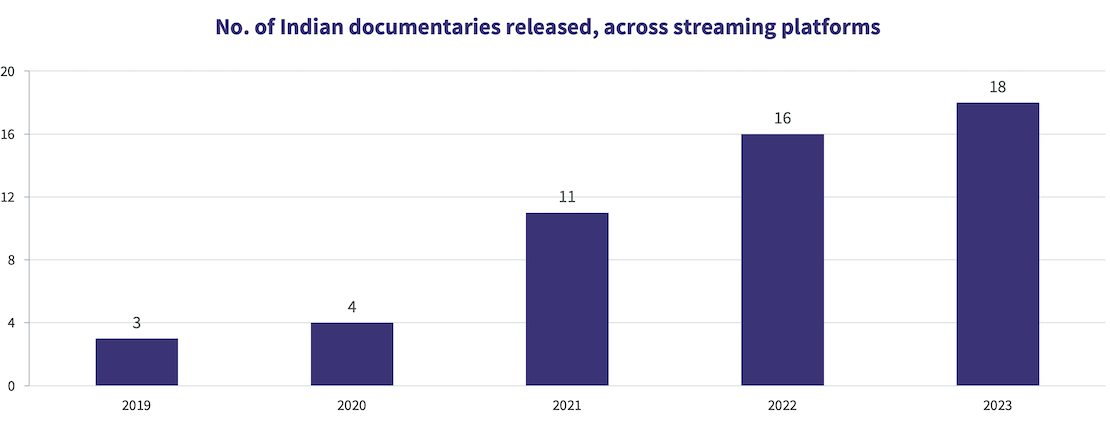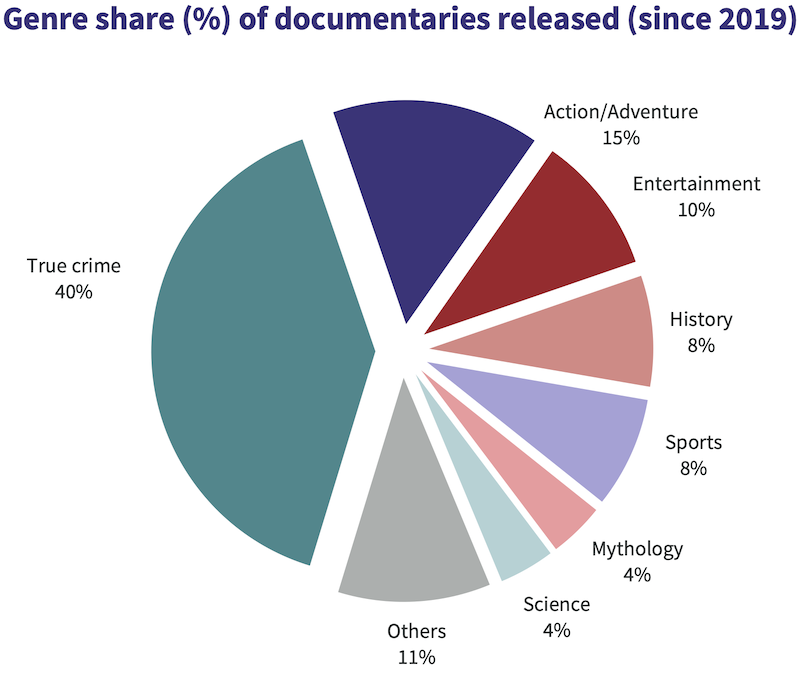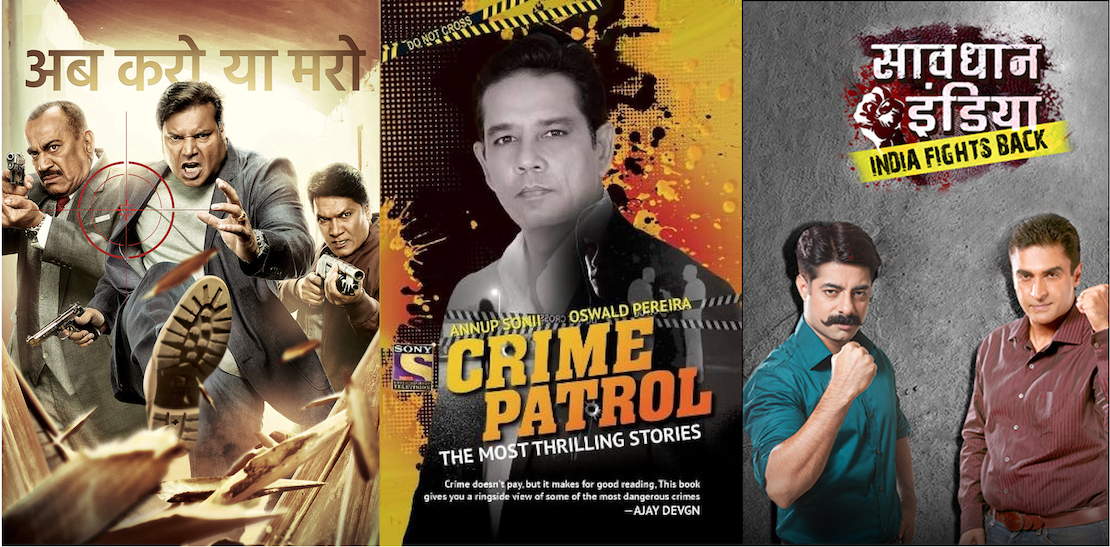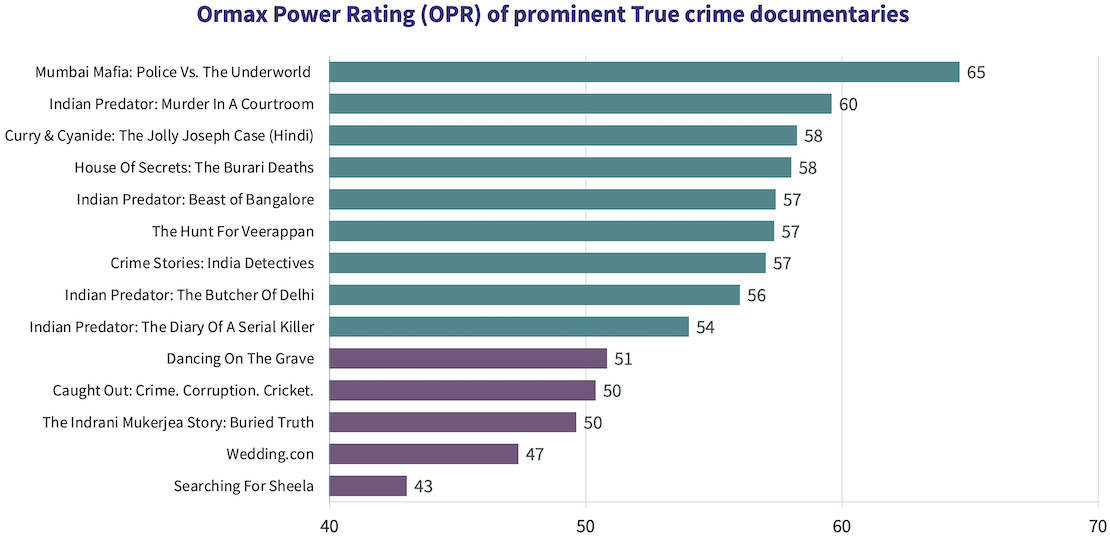


By Swayam Kumar, Soumya Vats
In recent years, documentaries in India have seen a significant rise, especially on streaming platforms like Netflix, Amazon Prime Video, and Disney+ Hotstar. Through these platforms, the Indian audience has had access to diverse and compelling stories, allowing them to explore a wide range of subjects from social justice to personal narratives. This shift has not only broadened the audience base for the format, but also pushed creators to explore the format in further depth and novelty.

52 documentaries have been released across major streaming platforms and languages in India, since 2019. Interestingly, a large portion of these documentaries belong to the True Crime genre (40%), significantly higher than any other genre.

Interestingly, not only does True Crime prevail in the category in terms of the high number of properties released, but it is also the most-liked genre of documentaries, with almost all high Ormax Power Rating (OPR) documentaries belonging to this genre. But what makes Indian audiences like content in this genre, what are their expectations from these shows, and how are they different from that of western audiences, where the documentary format has a longer and more established history? To answer these questions, one has to delve deeper into their content, and zoom out to understand the historical context in which these properties are being consumed.
Indian television’s shadow on the genre
Indian audiences' interest in the True Crime genre was born much before the genre’s strong association with the documentary format. The collective cultural recollection of watching late-night shows of Crime Patrol and Savdhaan India, or indulging in investigative narratives of CID on primetime television, hints at a behavioral pattern of Indian audiences consciously seeking narratives rooted in true occurrences. Naturally, Indians’ interest in true crime is governed by their need to consume it through a linear and dramatized narrative, underscoring that the audience’s expectation is more driven by story than by insight.

What differentiates successful Indian documentaries from their western counterparts?
Through the immense popularity of critically-acclaimed western true crime documentaries such as the Conversations With A Killer franchise and The Staircase, it can be deduced that western audiences seek a greater procedural deconstruction of the crime, and a complex portrayal of the criminal. The elements to fulfill this often include an autopsy-like elaborate description of crime scenes, a multitude of varying expert perceptions, an elongated focus on investigative proceedings, and a certain ambiguity in terms of conviction and intent. Curiously, these elements are in friction with the straightforward and palatable storytelling as preferred by Indian audiences. Rather, India’s narrative-driven sensibilities (with roots in the above-mentioned dramatized properties from television), better respond to uncomplicated narratorial structures, propelled forward with consistent visual stimulation, that aid in maximizing emotional immersion, instead of cognitive analysis.
The chart below compares the various prominent True Crime documentaries on their Ormax Power Rating (OPR), our proprietary metric to measure audience likeability of all content, ranging from theatrical films to streaming originals to linear television shows. OPR is reported on a 0-100 scale, and can be seen as a representation of the show’s inherent content strength, and is also a surrogate for its advocacy, i.e., % audience who are likely to recommend the content to their friends or family after watching it.

The top-performing Indian true crime documentaries leveraged their narrative palatability to appeal to wide audiences. The Indian Predator franchise forms an important example of this, consistently implementing varied tools to enhance its storytelling. While Murder in a Courtroom utilizes a powerful rap in the opening scene to add heft to the women’s purpose, The Butcher of Delhi maps out the immense scale of the crime by tracing similar murders across several years, Diary of a Serial Killer includes interviews juxtaposed with dramatic re-enactments to preserve authenticity, and Beast of Bangalore captures the viewer’s attention by hinting at how an ominous beastly presence scars a serene new city. Similarly, Mumbai Mafia’s reliance upon fictional re-enactments as the bridge between exposing the different elements of Mumbai’s underworld, executed through slow-paced visual storytelling, provide the audience with an avenue for a strong emotional grounding.
Curry & Cyanide, a more organic portrayal of the crime, also implements a dynamic visual chart that chronologically maps out the subject’s murders, increasingly horrifying with each death. It narrowly escapes the trap that other shows like The Indrani Mukherjea Story: The Buried Truth, Dancing on the Grave and House of Lies: Burari fall into: demystifying the criminal through opposing perspectives, a style and form that finds relatively greater acceptance among western audiences. These public cases fail to offer anything not already in the public eye, instead focusing on delving into inconclusive personal insights and resisting a closure that is considered essential to a successful narrative. This narrative style, as well as a nuanced deep-dive into the psyche of a possible criminal, is far less engaging to an Indian audience than knowing the truth about horrific crimes, and witnessing them in a fictionalized manner, as opposed to only witnessing talking-heads opine about them.
When one speaks of localization of content, documentaries prove to be the most fascinating riddles. If an inherently informative format such as documentaries wants to make its place in a local landscape of content which is dominated by escapist fiction, it must present its information consciously by being mindful of the roots of crime content in India. This is not to say that documentaries need to be limited to a stringent box or be overly simplified to thrive among the Indian audiences, but rather that they embrace the cultural power of storytelling to imbue them with a gratifying Indian flavor.

From CTV to Micro Dramas: India's fascinating OTT spectrum
The simultaneous rise of Connected TV and Micro Drama audiences in India over the last year highlights how the Indian OTT market is expanding at both the premium and the mass ends simultaneously

Product update: Content testing for the horror genre
Based on our accumulated audience insights, we are introducing genre-specific drivers for horror films and series in our content testing tools, Ormax Moviescope and Ormax Stream Test

Streaming has a new bias: The male lead
An analysis of 338 Hindi fiction originals since 2022 highlights a growing imbalance in the Indian streaming ecosystem, with male-led stories steadily taking over
Subscribe to stay updated with our latest insights
We use cookies to improve your experience on this site. To find out more, read our Privacy Policy